I'm comparing a set of eight algorithms (solver column) using a set of instances, each instance is executed once for each algorithm and a level of a parameter D (goes from 1 to 10). So, the resulting data frame would look like this:
instance D z solver
0 1000_ep0.0075 1 994 threatened
1 1000_ep0.0075 1 993 desc
2 1000_ep0.0075 1 994 degree
3 1000_ep0.0075 1 993 threatened_desc
4 1000_ep0.0075 1 993 threatened_degree
5 1000_ep0.0075 1 994 desc_later
6 1000_ep0.0075 1 994 degree_later
7 1000_ep0.0075 1 993 dyn_degree
8 1000_ep0.0075 2 986 threatened
9 1000_ep0.0075 2 987 desc
10 1000_ep0.0075 2 988 degree
11 1000_ep0.0075 2 987 threatened_desc
12 1000_ep0.0075 2 986 threatened_degree
13 1000_ep0.0075 2 987 desc_later
14 1000_ep0.0075 2 988 degree_later
15 1000_ep0.0075 2 987 dyn_degree
....
Where the z column corresponds to the value found by the algorithm (smaller the better).
I would like to add a column to the dataframe, corresponding to the rank of each algorithm according to the value of z for each combination <instance, D>. For the example above, would be something like this:
instance D z solver z_rank
0 1000_ep0.0075 1 994 threatened 2
1 1000_ep0.0075 1 993 desc 1
2 1000_ep0.0075 1 994 degree 2
3 1000_ep0.0075 1 993 threatened_desc 1
4 1000_ep0.0075 1 993 threatened_degree 1
5 1000_ep0.0075 1 994 desc_later 2
6 1000_ep0.0075 1 994 degree_later 2
7 1000_ep0.0075 1 993 dyn_degree 1
8 1000_ep0.0075 2 986 threatened 1
9 1000_ep0.0075 2 987 desc 2
10 1000_ep0.0075 2 988 degree 3
11 1000_ep0.0075 2 987 threatened_desc 2
12 1000_ep0.0075 2 986 threatened_degree 1
13 1000_ep0.0075 2 987 desc_later 2
14 1000_ep0.0075 2 988 degree_later 3
15 1000_ep0.0075 2 987 dyn_degree 2
...
Using python-pandas, this is what I could get so far:
df.loc[:, 'z_rank'] = df_rg.groupby(['instance', 'D'])['z'].rank()
df.head(16)
instance D z solver z_rank
0 1000_ep0.0075 1 994 threatened 47.5
1 1000_ep0.0075 1 993 desc 16.5
2 1000_ep0.0075 1 994 degree 47.5
3 1000_ep0.0075 1 993 threatened_desc 16.5
4 1000_ep0.0075 1 993 threatened_degree 16.5
5 1000_ep0.0075 1 994 desc_later 47.5
6 1000_ep0.0075 1 994 degree_later 47.5
7 1000_ep0.0075 1 993 dyn_degree 16.5
8 1000_ep0.0075 2 986 threatened 7.0
9 1000_ep0.0075 2 987 desc 18.5
10 1000_ep0.0075 2 988 degree 44.5
11 1000_ep0.0075 2 987 threatened_desc 18.5
12 1000_ep0.0075 2 986 threatened_degree 7.0
13 1000_ep0.0075 2 987 desc_later 18.5
14 1000_ep0.0075 2 988 degree_later 44.5
15 1000_ep0.0075 2 987 dyn_degree 18.5
Which is clearly not what I want.
Could somebody help me with that?
